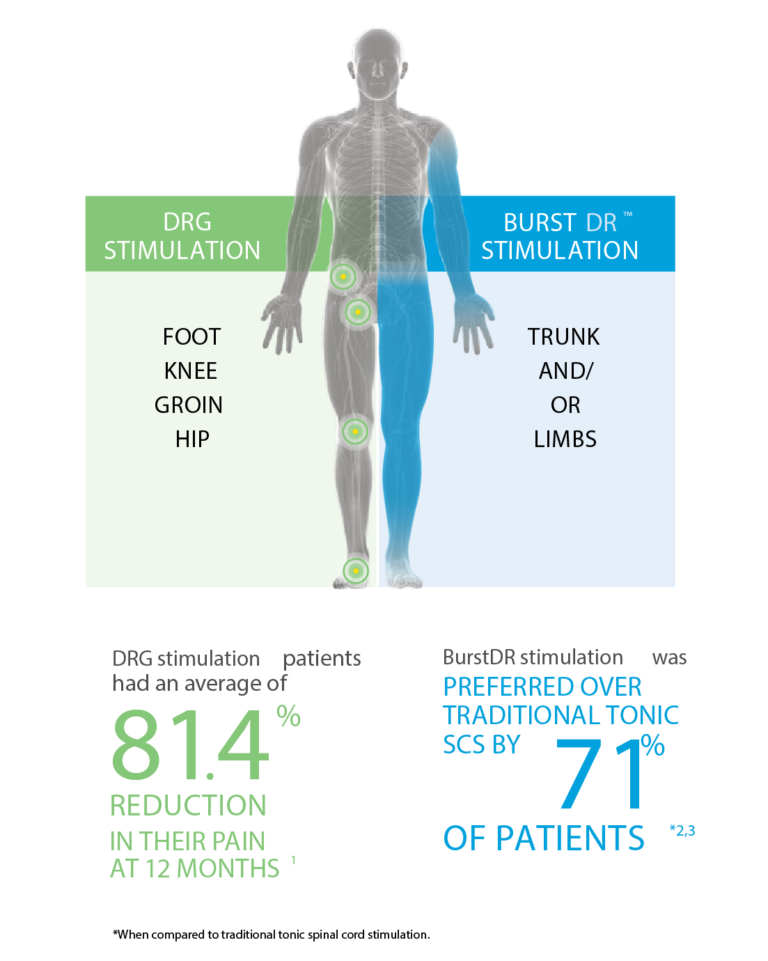Spinal Cord Stimulation
Back Pain Symptoms
There is a wide variation in back pain symptoms, as the symptoms correspond to the cause. Signs and symptoms of back pain include:
Shooting, or stabbing, pains
Muscle aches
Limited flexibility, range of motion
Pain that affects the legs, often radiating in nature
What Is Spinal Cord Stimulation?
SCS, also known as spinal cord stimulation, utilizes electrical impulses to relieve persistent pain of the back, arms, and legs. The treatment is founded on the commonly accepted basis that electrical pulses block pain signals from being accepted by the brain.  Spinal cord stimulation (SCS) patients include people who are affected by neuropathic pain, and for those who fail to respond to more conservative treatments.
Spinal cord stimulation (SCS) patients include people who are affected by neuropathic pain, and for those who fail to respond to more conservative treatments.
all pain is not equal
With two proven superior therapies, only Balog Regenerative and Portland Pain and Spine gives you multiple ways to treat your pain and achieve improved outcomes. Whether your pain is precise or pervasive, Dorsal Root Ganglion (DRG) and BurstDR™ stimulation* give you opportunities to receive better relief. Choose the most effective therapy that’s tailored to your pain, because all pain is not equal.
If you suffer from chronic pain in any of the areas listed, please contact Balog Regenerative today to set up a consultation to take back your life!

What does the procedure look like?
The injection area is an esthetized, and one, or multiple, insulated wire leads are slid inside either an epidural needle or through a small incision into the area surrounding the spinal column. This is also known as the epidural space.
esthetized, and one, or multiple, insulated wire leads are slid inside either an epidural needle or through a small incision into the area surrounding the spinal column. This is also known as the epidural space.
An electrode located at the end of the wire lead generates an electrical pulse, triggering the nerves and blocking the pain signals. The patient is then encouraged to provide feedback to assist the physician to identify the most effective location for the lead in alleviating pain. These leads are connected to an external trial stimulator, which will be utilized for about a week determining if spinal cord stimulation will be effective.
If the patient and physician determine that the amount of pain relief is notable, the system may be permanently implanted. At the end of the trial implantation, the leads are removed.
If the trial implantation proves successful, the permanent implantation can be administered by the physician. After the patient is anesthetized or sedated, the initial step is to insert one or more permanent leads via an epidural needle or through a small incision. The leads are inserted into the area of the epidural space predetermined in the trial implantation.
An implantable pulse generator, or IPG battery, is planted under the skin. It is commonly placed in the abdomen or the buttocks. The leads are then connected to the IPG.
Using an external wireless programming device, the implant’s electrical pulses are programmed. The patient can program the device themselves to adjust the stimulation level, turn the system on or off, and toggle the implant through different programs. Patients may still experience some discomfort and swelling at the incision area for a number of days.
